Patent Office
by Elton Gish
Reprinted from "Crown Jewels of the Wire", April 1997, page 21
LUSIGNAN PATENTS FOR FOG-TYPE
SUSPENSION INSULATOR
Several years ago Mike Guthrie (NIA #3297) reported an unusual fog-type
suspension insulator made by the Ohio Brass Co. The insulator was not marked but
it did have the O-B logo prominently marked on both cast iron caps. It was
composed of two parts that could be screwed together by means of a metal pin
cemented in the center of each part. The top porcelain part was in the form of a
large bowl with typical cast iron metal cap cemented on the top with a large
hook attached from which the insulator was suspended. The bottom part consisted
of a small porcelain disk with a cap cemented on it. The conductor (or
additional insulator assemblies) was attached to the metal cap of the smaller
part. The top part looks like a fogbowl insulator and the bottom part fits up
inside the fogbowl when the two parts are screwed together. The top fogbowl has
a small petticoat that extends down and fits inside the groove between the
upwardly projecting petticoat and outer skirt of the bottom part. The petticoat
on the bottom part of Mike 's insulator had been broken off, probably after the insulator was removed from service.
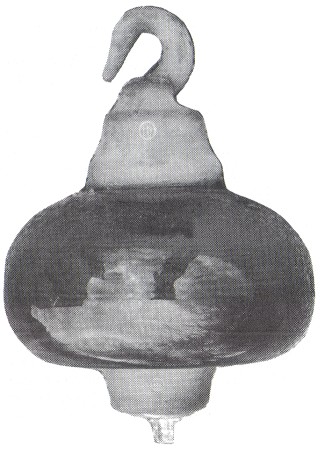
The
purpose of this design was to provide a large surface that would not be exposed
to rain and fog and thus remain relatively dry to prevent or reduce electrical
leakage. The top fogbowl part completely shielded the smaller inner disk and the
intermeshing of the two sets of petticoats provided additional protection from
wetting and a sufficient leakage path that could be potentially kept dry.
The
color and characteristics of the glaze suggested that the insulator was made in
the 1930's. This suspicion was verified when it was discovered that two patents
covered this basic design. Joseph T. Lusignan, Jr. was an employee of the Ohio
Brass Co. in Mansfield, Ohio. He filed two patent applications (January 17, 1933
and June 2, 1934) for the idea of a two-part fog-type suspension insulator. He
was granted patent Nos. 1,994,281 and 1,994,282 on March 12, 1935.
The first
patent had a somewhat shallow bowl-shaped top part and a smaller bowl-shaped
bottom part that fit part of the way inside the top part. The long petticoat of
the top part fit inside the deep groove of the bottom part which was formed
between the petticoat and outer skirt. Additional claims were made for trimming
a groove around the insulator parts at the edge of the metal cap and filling it
with a conductive coating to prevent corona effects and the resultant radio
interference.
Mike's insulator fully embodies the claims of the second patent
which consisted of a large bowl-shaped top part that fully protected the smaller
disk which fit up inside the bowl. The petticoats on both parts were shorter
which obviously made the insulator easier to manufacture, and the completely
enclosed bottom disk offered better protection from moisture than the more
shallow bowls illustrated in Lusignan's first patent. The second patent claimed
the simpler method of spraying a thin conductive coating under the edge of the
metal cap for prevention of radio interference effects.
I have copies of Ohio Brass catalogs from 1934, 1935-39, 1939, 1940, 1947,
and 1949 which would be the probable years of manufacture for this insulator.
However none of the catalogs showed the Lusignan insulator. Another fog-type
suspension was shown in each catalog which had a simple bell shape with several
external horizontal petticoats trimmed in the outer vertical surface. I suspect
that the Lusignan insulator did not gain favor with utility companies because
the two-part design made it more difficult to install and had offered a greater
potential for breakage. There may also have been consideration given to the
difficulty of making the large bowl-shaped top part compared to trimming
external horizontal petticoats on the fog-type suspension shown in the catalogs.
The two-part design was more complicated and thus probably more expensive to
make.
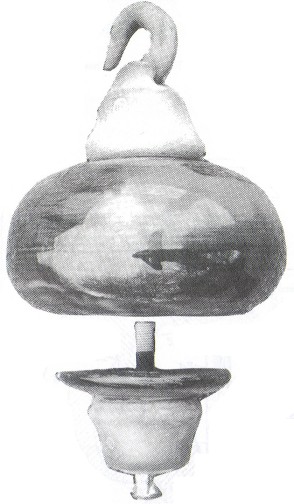
Mike's insulator [now owned by Bill Rohde (NIA #1219)] is the only one I have
seen. We would like to hear from anyone else who has this insulator or possibly
an example of the design shown in Lusignan's first patent.
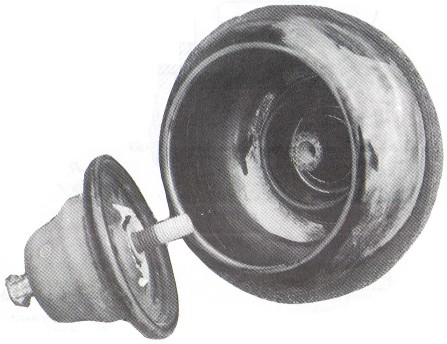
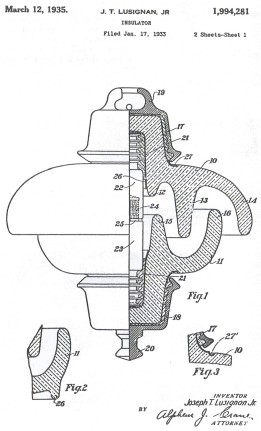
Medium Image (75 Kb)
Large Image (168 Kb)
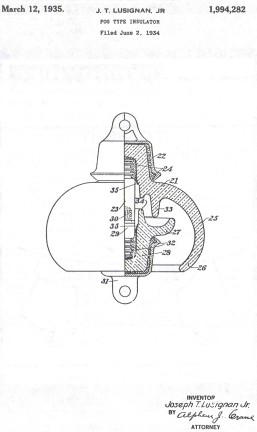
Medium Image (51 Kb)
Large Image (118 Kb)
| 